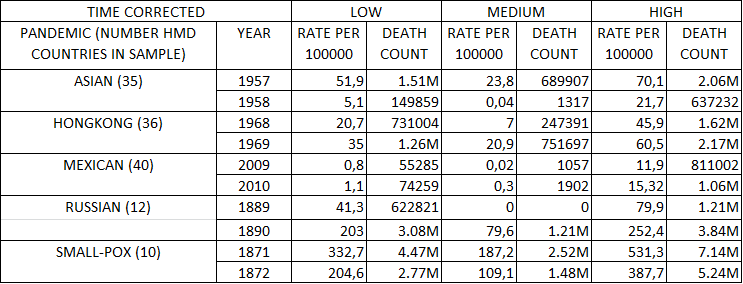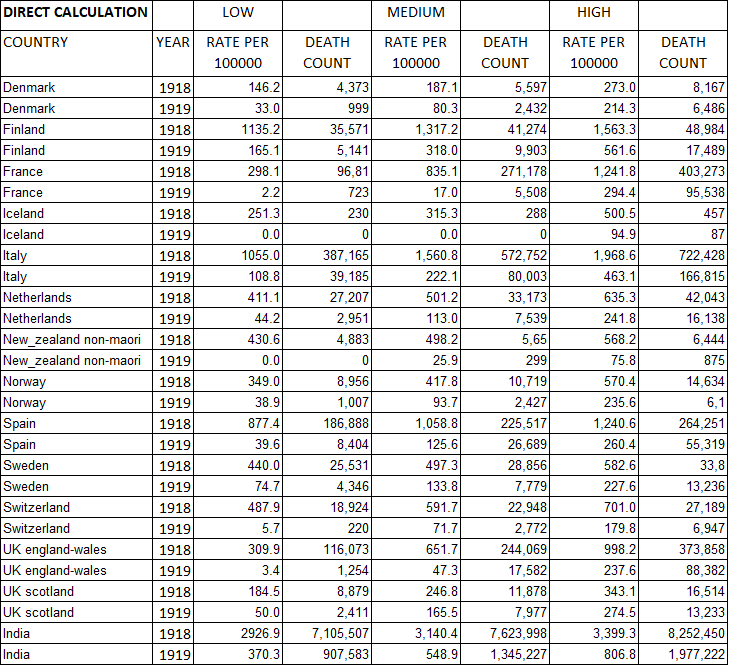 Background
Background
 Nivel's ongoing project Global Mortality Influenza Research is part of the dossier Epidemiology of Respiratory Viruses, which consists of several projects on monitoring and researching respatory viruses on a global scale.
Nivel's ongoing project Global Mortality Influenza Research is part of the dossier Epidemiology of Respiratory Viruses, which consists of several projects on monitoring and researching respatory viruses on a global scale.
 Aim
Aim
By assessing the mortality impact of former pandemics, we participate in research which is essential for optimizing public health responses to future pandemics.
 Sharing our research and results
Sharing our research and results
We share our research and its results in providing access to our mortality estimates. You will find our research and our estimates in these five categories:
- Pandemic mortality estimates
-
About the 1918 influenza pandemic (based on all-cause mortality)
About the 2009 influenza pandemic (based on respiratory mortality)
- Publication:
2013 |Global Mortality Estimates for the 2009 Influenza Pandemic from the GLaMOR Project: A Modeling Study. Simonsen L, Spreeuwenberg P, Lustig R, Taylor RJ, Fleming DM, Kroneman M, Van Kerkhove M, Mounts AW, Paget WJ, the GLaMOR Collaborating Teams. Plos Medicine 2013 Nov;10(11):e1001558
Summary:
The World Health Organization reported 18,631 laboratory-confirmed deaths during the 2009 pandemic. We estimated the mortality burden through statistical modeling of mortality data from multiple countries. Between 123,000 and 203,000 pandemic respiratory deaths were estimated globally for 2009, with the majority (62-85%) of deaths attributed to persons under 65 years of age.
- Publication:
Monitoring the mortality impact of COVID-19 in Europe: What can be learned from 2009 influenza H1N1p mortality studies? Staadegaard L, Taylor RJ, Spreeuwenberg P, Caini S, Simonsen L, Paget J. International Journal of Infectious Diseases. 2020 Oct 16;S1201-9712(20)32241-4.
Summary:
Understanding the proportion of pandemic deaths captured as "laboratory-confirmed" deaths is crucial. We assessed the ability of laboratory-confirmed deaths to capture mortality in the European Union during the 2009 pandemic, and found these to be more accurate than previously assumed. We examined the likelihood that these findings are applicable to the SARS-CoV-2 pandemic, and hypothesize that this method is less reliable for SARS-CoV-2.
About other pandemics (based on all-cause mortality)
- Publication:
2018 | Reassessing the Global Mortality Burden of the 1918 Influenza Pandemic. Speeuwenberg P, Kroneman M, Paget J. American Journal of Epidemiology. 2018;187(12):2561-2567.
Summary:
Other pandemics we did research on are those of: 1871-72 (smallpox) 1889-90 (influenza); 1958-59 (influenza); 1968-69 (influenza) 2009-10 (influenza). The mortality estimates of the pandemics are based on an indirect estimation approach and the publicly available data from the Human Mortality Database. See the Supplement, page 16 (death counts are in millions(M)).

- Predictors for 2009 pandemic mortalit
-
About the 2009 Influenza Pandemic (based on respiratory mortality)
- Publication:
2017 | Possible explanations for why some countries were harder hit by the pandemic influenza virus in 2009 – a global mortality impact modeling study. BMC Infectious Diseases. 2017; 17: 642. Published online 2017 Sep 25.
Summary:
As a starting point for this analysis, we identified possible risk factors worth investigating for Influenza A(H1N1)pdm09 mortality through a targeted literature search. We then used a modeling procedure (data simulations and regression models) to identify factors that could explain differences in respiratory mortality due to influenza A(H1N1)pdm09.
Our study found that countries with a large proportion of young persons had higher pandemic mortality rates in 2009. Other factors that were significant were: latitude, virus circulation (in the previous year and during 2009), air pollution, TB and HIV. Healthcare expenditure, levels of obesity, the distribution of antivirals and air travel did not explain global pandemic mortality differences.
- Seasonal influenza mortality estimates
-
About the season 2002 - 2011 (based on respiratory mortality)
- Publication:
2019 | Global mortality associated with seasonal influenza epidemics: New burden estimates and predictors from the GLaMOR Project. Paget J, Spreeuwenberg P, Charu V, Taylor R, et al. Journal of Global Health. 2019; 9(2): 1-12.
Summary:
We compiled influenza-associated excess respiratory mortality estimates for 31 countries representing five WHO regions during 2002 - 2011. From these we extrapolated the influenza burden for all 193 countries of the world using a multiple imputation approach.
We estimated an average of 389 000 (uncertainty range 294 000 - 518 000) respiratory deaths were associated with influenza globally each year during the study period; two-thirds (67%) were among people 65 years and older.
How do the GLaMOR estimates compare to other estimates?
- Publications:
2022 | Estimates of mortality associated with seasonal influenza for the European Union from the GLaMOR project. Paget, J., Iuliano, A.D., Taylor, R.J., Simonsen, L., Viboud, C., Spreeuwenberg, P. Vaccine. 2022, 40(9):1361-1369
Summary:
The European Centres for Disease Prevention and Control (ECDC) estimates that seasonal influenzacauses 4-50 million symptomatic infections in the EU/EEA each year and 15,000-70,000 European citizens die of causes associated with influenza. We used modelling methods to estimate influenza-associated mortality for the European Union by age group and country.
2021 | Global seasonal influenza mortality estimates: a comparison of three different approaches. Cozza V, Campbell H, Chang HG, Iuliano AD, Paget J, Patel NN, Reiner RC, Troeger C, Viboud C, Bresee JS, Fitzner J. American Journal of Epidemiology. 2021 190(5), p. 718-727
Summary:
The World Health Organization convened a consultation in July 2017 to understand differences in methodology and implications on results of three influenza mortality projects from the United States Centers for Disease Control and Prevention (CDC), the Netherlands Institute for Health Service Research (GLaMOR), and the Institute for Health Metrics and Evaluation (IHME). The expert panel reviewed estimates and discussed differences in data sources, analysis, and modeling assumptions. This publication presents the findings of the expert panel.
- Factors associated with seasonal influenza mortality
-
About the season 2002 - 2011 (based on respiratory mortality)
- Publication:
2019 | Global mortality associated with seasonal influenza epidemics: New burden estimates and predictors from the GLaMOR Project. Paget J, Spreeuwenberg P, Charu V, Taylor R, et al. Journal of Global Health. 2019; 9(2): 1-12.
Summary:
We estimated influenza-associated excess respiratory mortality for 193 countries in the world over nine seasons (2002 - 2011). We then used mixed linear regression models to identify factors associated with high seasonal influenza mortality burden, including influenza types and subtypes, health care and socio-demographic development indicators, and baseline mortality levels.
- For people <65 years, higher baseline respiratory mortality, lower level of access to health care and seasons dominated by the A(H1N1)pdm09 subtype were associated with higher influenza-associated mortality.
- For adults ≥65 years, lower level of socio-demographic development and A(H3N2) dominance was associated with higher influenza mortality.
- Data freely available for researchers
-
About the 1918 pandemic mortality (based on all-cause mortality)
- Publication:
2018 | Reassessing the Global Mortality Burden of the 1918 Influenza Pandemic. Speeuwenberg P, Kroneman M, Paget J. American Journal of Epidemiology. 2018;187(12):2561-2567.
Summary:
We present individual country estimates for the three scenario’s using the direct calculation method, country results are the pooled estimates from the 10 age categories. (The estimates below are NOT corrected for time trend and war.)
See the Supplement, page 8.

About the 2009 pandemic mortality (based on respiratory mortality)
About the seasonal influenza mortality 2002-2011 (based on respiratory mortality)
 Research program and partners
Research program and partners
Most of this work has been carried out in the context of the Global Influenza Mortality project (GLaMOR), which was funded by WHO Headquarters (Global Influenza Programme). This work is particularly important in the context of the COVID-19 pandemic as there is plenty of interest at the moment of comparing influenza mortality to COVID-19 mortality.
 Want to know more?
Want to know more?
For more information on this project, please feel free to get in touch with the Nivel expert(s) involved. You will find them on the right, together with the (future) Nivel deliverables (publications) and other relevant content.
Kroneman, M. Project Global Influenza Mortality Research. From: www.nivel.nl [Last update 15-November-2023; consulted on 01-May-2025]. URL: https://www.nivel.nl/en/dossier-epidemiology-respiratory-viruses/influenza-mortality
 Nivel's ongoing project Global Mortality Influenza Research is part of the dossier Epidemiology of Respiratory Viruses, which consists of several projects on monitoring and researching respatory viruses on a global scale.
Nivel's ongoing project Global Mortality Influenza Research is part of the dossier Epidemiology of Respiratory Viruses, which consists of several projects on monitoring and researching respatory viruses on a global scale.
